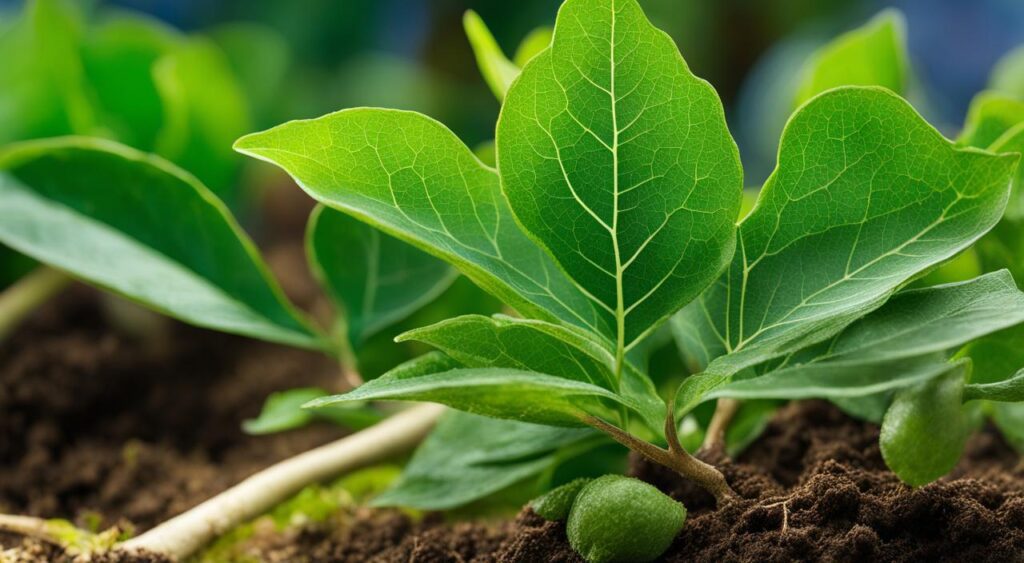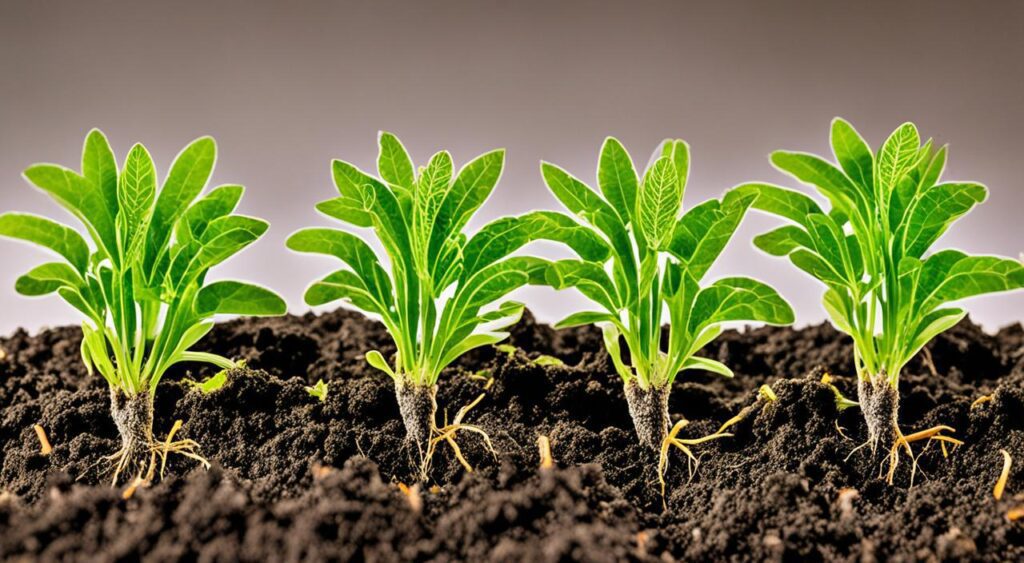In this section, I will delve into the cycling process and plant growth essentials. We will explore the various cycling processes in the plant kingdom, including carbon cycling, nitrogen cycling, and phosphorus cycling. Understanding these processes is crucial for plant growth and the overall dynamics of ecosystems.
Key Takeaways:
- Plant nutrient cycling is vital for sustaining the health and growth of plants.
- Carbon cycling in plants involves the exchange and transformation of carbon compounds.
- Nitrogen cycling in plants involves the movement and transformation of nitrogen compounds.
- Phosphorus cycling in plants involves the movement and transformation of phosphorus compounds.
- The cycling processes in the plant kingdom contribute to ecosystem dynamics and biodiversity.
The Importance of Plant Nutrient Cycling
Plant nutrient cycling is a crucial process that significantly impacts the health and growth of plants. It involves the movement and exchange of essential nutrients, such as carbon, nitrogen, and phosphorus, between various biotic and abiotic reservoirs in ecosystems. This cycling process is essential for the balance and dynamics of ecosystems, supporting plant growth and overall ecosystem health.
A critical aspect of plant nutrient cycling is organic matter cycling in plants. Organic matter, such as dead plant material and decaying leaves, is critical in providing essential nutrients to the soil. As organic matter decomposes, nutrients are released and available for plant uptake. This organic matter cycling ensures that plants can access the necessary nutrients for growth and development.
Furthermore, nutrient cycling in soil contributes to plant growth by replenishing the nutrient levels in the soil. Nutrients taken up by plants are eventually returned to the soil through various processes, such as root exudation, litterfall, and decomposition of plant residues. Other plants can then utilise these nutrients, creating a continuous cycle of nutrient availability.
The interconnected nature of plant nutrient cycling and ecosystem dynamics highlights the importance of this process. By cycling nutrients between plants and the environment, plants contribute to ecosystems’ overall health and sustainability. This cycling process helps regulate nutrient availability, maintain biodiversity, and support the growth and development of other organisms within the ecosystem.
Understanding and promoting plant nutrient cycling is crucial for sustainable land management and conservation efforts. By maintaining healthy cycling processes, we can ensure plant life’s long-term growth and vitality and the ecosystems they inhabit.
| Benefits | Description |
|---|---|
| Improved nutrient availability | Plant nutrient cycling enhances the availability of essential nutrients in the soil, ensuring a steady supply for plant uptake. |
| Enhanced soil fertility | Nutrient cycling helps enrich the soil with organic matter, improving its fertility and nutrient-holding capacity. |
| Regulation of nutrient balance | By cycling nutrients between plants and the environment, nutrient cycling helps maintain a balanced nutrient ecosystem. |
| Promotion of biodiversity | Nutrient cycling supports the growth of diverse plant species, which in turn supports a wide variety of organisms in the ecosystem. |
| Energy flow regulation | The cycling of nutrients helps regulate the flow of energy within ecosystems, supporting the overall functioning of the ecosystem. |
Understanding Carbon Cycling in Plants
Carbon cycling in plants plays a crucial role in plant growth and nutrient cycling. It refers to how carbon compounds are exchanged and transformed within plant and soil systems. This cycling process is essential for producing organic matter, a vital source of nutrients for plants and other organisms in the ecosystem.
During photosynthesis, plants absorb carbon dioxide from the atmosphere and convert it into organic carbon compounds like carbohydrates. These compounds are essential for plant growth and metabolism. Through respiration, plants release carbon dioxide into the atmosphere as a byproduct.

Additionally, carbon can be stored in the soil as organic matter through decomposition. When plants and other organic materials decompose, the carbon they contain is broken down and released into the soil. This stored carbon contributes to the overall nutrient content of the soil, benefiting plant growth and ecosystem health.
The cycling of carbon in plants is closely intertwined with nutrient cycling. Carbon is a critical component of carbohydrates and other organic compounds that provide energy and building blocks for plant growth. Therefore, carbon cycling is essential for the availability of nutrients necessary for plant growth and overall ecosystem dynamics.
The Role of Carbon Cycling in Plant Growth and Nutrient Cycling
Carbon cycling is intricately linked to other cycling processes, such as nitrogen and phosphorus cycling, which are crucial for plant growth and development. The availability of carbon compounds influences the availability and uptake of other essential elements for plant nutrition.
| Nutrient | Role in Plant Growth | Source of Nutrients |
|---|---|---|
| Nitrogen | Essential for protein synthesis and overall plant growth | Atmospheric nitrogen fixation, organic matter decomposition |
| Phosphorus | Key component for energy transfer and DNA synthesis | Weathering of rocks, organic matter decomposition |
As plants utilize carbon compounds during growth and metabolism, they release organic matter into the soil by decomposing root exudates, decaying plant material, and microbial activity. This organic matter enriches the soil with essential nutrients, including nitrogen and phosphorus, further supporting plant growth and nutrient cycling.
In turn, healthy plant growth and nutrient cycling contribute to ecosystems’ overall productivity and stability. Carbon cycling ensures the availability of organic matter and nutrients, supporting the growth of plants, which serve as the foundation for food webs and energy flow within ecosystems. It is a vital process that sustains the balance and functioning of both terrestrial and aquatic ecosystems.
Exploring Nitrogen Cycling in Plants
Nitrogen cycling in plants is a vital process that involves the movement and transformation of nitrogen-containing compounds within plant and soil systems. Nitrogen, an essential nutrient for plant growth and development, undergoes a series of conversions and transfers facilitated by various biological and chemical processes. Let’s delve deeper into the intricacies of nitrogen cycling and its significance in plant growth and nutrient cycling.
The Nitrogen Cycle
The nitrogen cycle is a complex and dynamic process that involves multiple stages and transformations. It primarily consists of the following key processes:
- Nitrogen Fixation: Atmospheric nitrogen gas (N2) is converted into a form that plants can utilize. This conversion is performed by nitrogen-fixing bacteria, which convert N2 into ammonium (NH4+) or nitrate (NO3–) ions—a process known as nitrogen fixation.
- Plant Uptake: Once the nitrogen is fixed into a usable form, plants can absorb it through their root systems. They incorporate these ions into essential molecules, such as proteins and nucleic acids, for growth and functioning.
- Nitrification: Nitrogen compounds, such as ammonium, can undergo nitrification—a process converts ammonium into nitrite (NO2-) and then further into nitrate. Nitrifying bacteria primarily carry out nitrification.
- Denitrification: Denitrification is the opposite of nitrogen fixation. It is a process where certain bacteria convert nitrate back into nitrogen gas, which is then released back into the atmosphere. Denitrification helps maintain the balance of nitrogen in the ecosystem.
- Mineralization: During decomposition, organic nitrogen from dead plants and animals is broken down and converted into ammonium. This release of ammonium contributes to the pool of available nitrogen in the soil.
Importance of Nitrogen Cycling
Nitrogen is an essential nutrient for plant growth and is crucial in various biological processes. It is a key component of proteins, nucleic acids, chlorophyll, and vitamins. Adequate nitrogen availability promotes vigorous plant growth, enhances photosynthesis, and improves overall plant health.
Nitrogen cycling is essential for maintaining a sustainable supply of nitrogen in ecosystems. By recycling nitrogen compounds through various processes like fixation, nitrification, denitrification, and mineralization, plants and other organisms can access the necessary nitrogen they need for growth and development. Additionally, efficient nitrogen cycling helps prevent nitrogen pollution in water bodies and reduces the need for synthetic fertilizers.
Understanding Phosphorus Cycling in Plants
Phosphorus cycling in plants is a crucial process influencing plant growth and nutrient cycling. Phosphorus is an essential nutrient for plants as it plays a vital role in energy transfer, DNA synthesis, and other metabolic processes.
Plants acquire phosphorus from the soil through their root systems. Once absorbed, phosphorus can be utilized immediately for growth or stored within the plant’s tissues. However, phosphorus availability in the soil can vary, and plants must incorporate mechanisms to ensure a continuous supply of this vital nutrient.
Phosphorus cycling involves the movement and transformation of phosphorus compounds within the plant and soil systems. Phosphorus is returned to the soil Through mineralization and organic matter decomposition, replenishing its availability for plant uptake.
The cycling of phosphorus benefits individual plants and contributes to the overall nutrient cycling in ecosystems. By replenishing the soil with phosphorus, this cycling process supports the growth and development of other organisms that depend on plants for sustenance.
The Importance of Phosphorus in Plant Growth
Phosphorus plays a crucial role in various plant growth processes. It is involved in the transfer and storage of energy, synthesising DNA and RNA, and forming crucial molecules like ATP (adenosine triphosphate).
ATP, often referred to as the cell’s ” energy currency, ” provides the necessary energy for plant growth and metabolic activities. Phosphorus is a crucial component of ATP, ensuring plants have sufficient energy for essential processes like nutrient uptake, root development, and overall growth.
Additionally, phosphorus is essential for forming cell membranes, providing structural integrity to plant cells. It aids in transporting sugars and other nutrients throughout the plant, facilitating growth and development.
Overall, phosphorus cycling in plants is critical for maintaining phosphorus availability and ensuring optimal plant growth and nutrient cycling in ecosystems.

The Role of Cycling Processes in Plant Growth and Ecosystem Dynamics
The cycling processes in the plant kingdom are crucial for plant growth and ecosystems’ overall dynamics. These processes ensure the availability of essential nutrients for plants, supporting their growth and the development of other organisms within the ecosystem.
Plant growth and nutrient cycling go hand in hand. As plants grow, they require various nutrients, such as carbon, nitrogen, and phosphorus, to support their metabolic processes. Cycling processes, including carbon cycling, nitrogen cycling, and phosphorus cycling, play a vital role in making these nutrients available to plants.
Cycling processes contribute to the maintenance of biodiversity within ecosystems. As plants utilize nutrients, they release byproducts that other organisms can utilize. This promotes the interconnectedness and interdependence of species in the ecosystem, ultimately fostering a thriving and balanced ecological community.
Cycling processes also regulate the flow of energy within ecosystems. Nutrient cycling ensures that energy is efficiently transferred through the trophic levels, providing sustenance for organisms at each level. This energy flow is essential for the ecosystem’s functioning and stability of food chains and food webs.
Understanding the interplay between cycling processes, plant growth, and ecosystem dynamics is paramount for effective ecosystem management and conservation efforts. Scientists and conservationists can develop strategies to optimize ecosystem health and resilience by studying these processes and their effects.
Overall, cycling processes in the plant kingdom are intricate and complex, but they play a critical role in sustaining plant growth and shaping ecosystem dynamics. By recognizing the significance of these processes, we can work towards preserving and nurturing the delicate balance of our natural world.

Conclusion
In conclusion, the cycling process and plant growth play a crucial role in the functioning of ecosystems. Understanding the various cycling processes in the plant kingdom, including carbon cycling, nitrogen cycling, and phosphorus cycling, is essential for sustainable land management and conservation efforts.
Plant nutrient cycling, which involves the movement and exchange of nutrients in ecosystems, is vital for plant growth and the overall dynamics of ecosystems. The cycling of organic matter in plants contributes to the availability of essential nutrients in the soil. In contrast, nutrient cycling in soil ensures that plants receive the necessary nutrients for their growth.
By promoting healthy cycling processes, we can support plant life’s long-term growth and vitality and the ecosystems they inhabit. This sustains biodiversity and regulates the flow of energy within ecosystems, thus maintaining the balance and dynamics of our natural environments.
FAQ
What is plant nutrient cycling?
Plant nutrient cycling refers to the movement and exchange of nutrients, such as carbon, nitrogen, and phosphorus, between the various biotic and abiotic reservoirs in ecosystems. It plays a critical role in sustaining the health and growth of plants and is essential for the overall dynamics of ecosystems.
What is carbon cycling in plants?
Carbon cycling in plants involves the exchange and transformation of carbon compounds within plant and soil systems. Plants absorb carbon dioxide from the atmosphere during photosynthesis, convert it into organic carbon compounds, and use it for growth and metabolism. Through respiration and decomposition, carbon is released back into the atmosphere or stored in the soil as organic matter.
How does nitrogen cycling in plants work?
Nitrogen cycling in plants involves the movement and transformation of nitrogen-containing compounds within plant and soil systems. Nitrogen gas in the atmosphere is converted into a usable form by nitrogen-fixing bacteria, which can be absorbed by plants as ammonium or nitrate ions. Plants utilize nitrogen for protein synthesis and other essential processes. Through processes like nitrification, denitrification, and mineralization, nitrogen is returned to the soil or released back into the atmosphere.
What is phosphorus cycling in plants?
Phosphorus cycling in plants involves the movement and transformation of phosphorus compounds within plant and soil systems. Phosphorus is an essential nutrient for plant growth and is involved in processes like energy transfer and DNA synthesis. Plants acquire phosphorus from the soil through their root systems. After being taken up by plants, phosphorus can be utilized for growth or stored in the plant’s tissues. Through processes like mineralization and organic matter decomposition, phosphorus is returned to the soil for future plant uptake.
Why are cycling processes important for plant growth and ecosystem dynamics?
Cycling processes in the plant kingdom are crucial for plant growth and play a vital role in overall ecosystem dynamics. These processes ensure the availability of essential nutrients for plants, which in turn support the growth and development of other organisms in the ecosystem. Nutrient cycling promotes biodiversity and regulates the flow of energy within ecosystems, making it essential for effective ecosystem management and conservation.





